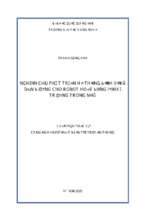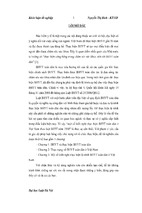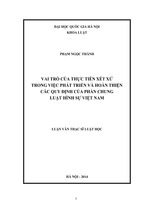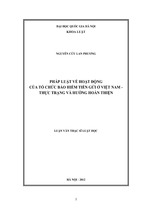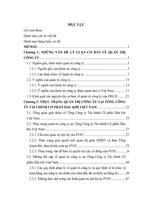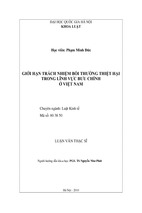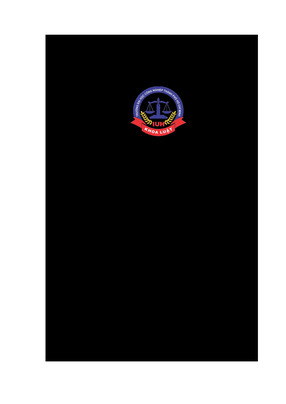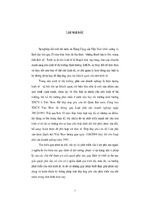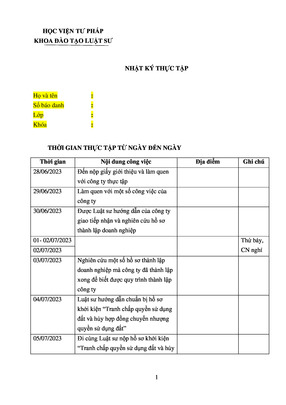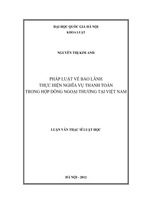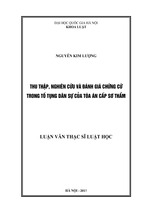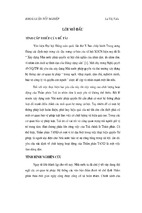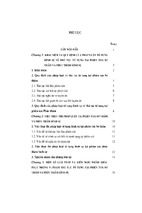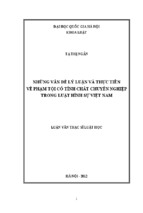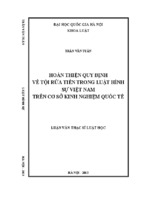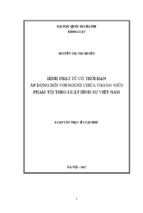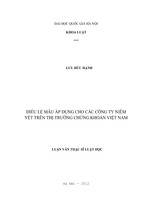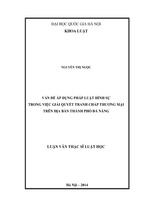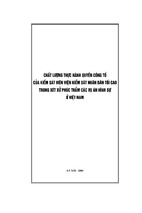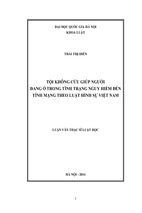MINISTRY OF EDUCATION AND TRAINING
HO CHI MINH CITY UNIVERSITY OF LAW
GRADUATION THESIS
B.A. DEGREE IN ENGLISH
Major: Legal English
(OBSTACLES TO ACCURATE LEGAL TRANSLATION AND FEASIBLE
SOLUTIONS TO THIS PROBLEM)
Supervisor: LUONG MINH HIEU, MA
Student: PHAM THI THAO LINH
Student ID: 1852202010038
Class: LE43B
Ho Chi Minh City, 2022
ACKNOWLEDGEMENT
Even though I am the author of my thesis, I could not have finished it without the
assistance of others around me. I want to thank everyone for your support, which helps
the process of writing this thesis become easier. The feedback, suggestions, and
compliments boost my confidence and motivate me to believe in myself.
First and foremost, I want to send an appreciation to Mr. Luong Minh Hieu, my
mentor, who put the most time and effort to help me finish this thesis. He was the one
who patiently sat down to guide me when I felt tough and confused during this process.
Obviously, the process of doing a thesis would be even more difficult and strenuous
without the teacher's dedicated guidance. Since I have never conducted any research
projects during my time at university, this project for me is a very advanced experience,
but also full of difficulties and challenges. The submission of this thesis marks my
maturity after a four-year academic career at the University of Law and opens up new
opportunities for the future.
Besides, I would like to thank the other lecturers of the Legal English department
as well as the teachers who have taught our class. All teachers and professors gave us the
most fundamental knowledge in the industry. Moreover, the enthusiasm of the teachers in
the teaching process is the biggest motivation for me to do the thesis. I want to leave a
research project as a very special mark in this student journey. Thank Ms. Pham Thi Thuy
Dung – my head teacher, she always takes the time to answer our questions as soon as
possible. In addition, I would like to express my sincere and deep gratitude to Mr. Tran
Thang Long (Deputy Head of Department of Legal English), Ms. Tran Ngoc Luong
Tuyen, Ms. Le Nguyen Thao Thy (lecturer in Deparment of Legal English), and all the
lecturers and staffs in Ho Chi Minh City University of Law for all the values and
knowledge I have received on her 4-year journey.
I also thank all Dat Bike staff, thank you Ms. Nguyen Thi Phuong Mai – Human
Resources Manager, Mr. Pham Duc Nam Trung – Head of Finance and Operation, Ms.
1
Truong Phan Cao Hoang Phuc – Legal Executive, and the entire Human Resources team
and Supply Chain team, who created a good environment for me to conduct surveys and
interviews, giving me a lot of lessons and additional useful information for me to
complete your thesis.
Additionally, from bottom of my heart, I would want to express my gratitude to my
best friends Hoa, Long, Nhi, and Ngoc for always being there and giving me the support,
and courage to go through all of the challenges I had to face while attending university.
Thanks to everyone who contributed to making my time in college more memorable and
colorful.
Last but not least, I would like to express my gratefulness to my family for always
being there for me, protecting me, and helping me succeed in my decision. Family is
always my reliable spiritual support when I am at my most vulnerable stage, loving me
without conditions and encouraging me every step of my journey of life. I sincerely
appreciate my parents for providing me with a superb learning and training environment
so that I can move forward with more confidence.
I am unable to mention everyone who has stood by me in silence over the past few
months because there are so many people supporting me in my very significant turning
point. However, in the end, for those whose names are not mentioned above, I still want
to send sincere appreciation to all people I love most, who lifted me up during my most
desperate time to become a better version of myself.
Ho Chi Minh City, 27th June, 2022
2
ABBREVIATION
SL: Source Language
TL: Target Language
CAT: Computer-Assisted Translation
3
LIST OF FIGURES
Figure 1: The complex factors affect to legal translation process ...................................... 38
Figure 2: Number of each object doing my survey ............................................................ 46
Figure 3: The number of years students learning English .................................................. 47
Figure 4: The fields which surveyors working in ............................................................... 47
Figure 5: The obstacles which people meet most when translating Legal English ............ 48
Figure 6: Characters of Legal Translation .......................................................................... 51
Figure 7: Common errors in Legal Translation .................................................................. 52
Figure 8: The satisfaction of legal translators .................................................................... 52
Figure 9: Tool usually used in Legal Translation............................................................... 54
Figure 10: Useful methods for Legal Translation ............................................................. 54
Figure 11: Legal translation process................................................................................... 55
Figure 12: Stages in Pre-translation process ...................................................................... 56
Figure 13: Factors for successful target text in Legal Translation ..................................... 57
Figure 14: CAT tools .......................................................................................................... 68
Figure 15: Legal Translation process ................................................................................. 70
4
LIST OF TABLES
Table 1: Challenges which translators have to cope with : ................................................ 50
5
TABLE OF CONTENTS
ACKNOWLEDGEMENT .................................................................................................... 1
ABBREVIATION ................................................................................................................ 3
LIST OF FIGURES .............................................................................................................. 4
LIST OF TABLES ............................................................................................................... 5
CHAPTER 1: INTRODUCTION......................................................................................... 9
1.1 Background to the Study ............................................................................................. 9
1.2 Rationale ................................................................................................................... 12
1.3 Aims of the Study and Research Questions .............................................................. 14
1.4 The Scope of the Study ............................................................................................. 15
1.5 The Significant of the Study ..................................................................................... 16
1.6 Study Methodology ................................................................................................... 17
1.6.1 Study Design ....................................................................................................... 17
1.6.2 Data Analysis ...................................................................................................... 18
1.6.3 Subject of the Study ............................................................................................ 18
1.7 Outline of the Study .................................................................................................. 19
CHAPTER 2: LITERATURE REVIEW............................................................................ 21
2.1 Translation in General ............................................................................................... 21
2.1.1 Definition of General Translation ....................................................................... 21
2.1.2 Translation Method ............................................................................................. 22
2.1.2.1 Word-to-word Translation ............................................................................ 23
2.1.2.2 Literal Translation ........................................................................................ 23
2.1.2.3 Faithful Translation ...................................................................................... 23
2.1.2.4 Semantic Translation .................................................................................... 23
2.1.2.5 Adaptation .................................................................................................... 24
2.1.2.6 Free Translation ............................................................................................ 24
2.1.2.7 Idiomatic Translation ................................................................................... 24
2.1.2.8 Communicative Translation ......................................................................... 24
2.2 Legal Translation ...................................................................................................... 24
2.2.1 Definition of Legal Translation .......................................................................... 25
6
2.2.2 When is a Document a Legal Document? .......................................................... 27
2.2.3 Characteristics of Legal Translation ................................................................... 29
2.2.3.1 The Nature of Legal Discourse .................................................................... 29
2.2.3.2 A System-bound Discipline ......................................................................... 31
2.2.3.3 Fidelity.......................................................................................................... 32
2.2.3.4 Ambiguity and interpretation ....................................................................... 34
2.3 Complexities of the Legal Translator........................................................................ 35
2.3.1 Language ............................................................................................................. 35
2.3.2 Legal System ...................................................................................................... 36
2.3.3 Genre ................................................................................................................... 36
2.3.4 Purpose................................................................................................................ 37
2.4 Strategies of Legal Translation ................................................................................. 38
CHAPTER 3: METHODOLOGY ..................................................................................... 43
3.1 Research Design ........................................................................................................ 43
3.1.1 Definition of Quantitative and Qualitative Research ......................................... 43
3.1.2 The Design of the Research ................................................................................ 43
3.2 The Procedure of Data Collection ............................................................................. 44
3.3 Data Analysis ............................................................................................................ 46
3.3.1 The Subjects of the Survey ................................................................................. 46
3.3.2 The Obstacles and Challenges which Translators Meet Most. ........................... 47
3.3.3 The Characters of Legal Translation .................................................................. 51
3.3.4 Common Errors in Legal Translation. ................................................................ 52
3.3.5 Useful Methods for Legal Translators. ............................................................... 53
3.3.6 Legal Translation Process ................................................................................... 55
3.3.7 Factors for Successful Target Text in Legal Translation ................................... 57
CHAPTER 4: DISCUSSION ............................................................................................. 58
4.1 The Obstacles that Prevent Translators from Producing Accurate Target Documents
......................................................................................................................................... 58
4.1.1 The Influence of Linguistic Aspect on Legal Translation .................................. 59
4.1.1.1 Latinisms ...................................................................................................... 59
4.1.1.2 Legalese ........................................................................................................ 60
7
4.1.2 The Influence of Legal Aspect on Legal Translation ......................................... 62
4.2 The Possible Solutions to Overcome above Mentioned Obstacles ........................... 63
4.2.1 Improve Knowledge and Experience.................................................................. 64
4.2.2. Applying the Legal Translation Process ............................................................ 65
4.2.3 The Aid of Technology in Legal Translation ..................................................... 66
4.3 The Legal Translation Process .................................................................................. 68
CHAPTER 5: CONCLUSION ........................................................................................... 71
5.1 Conclusion................................................................................................................. 71
5.2 Limitations of the Study ............................................................................................ 72
5.3 Further Study............................................................................................................. 73
REFERENCES ................................................................................................................... 74
APPENDIX ........................................................................................................................ 76
8
CHAPTER 1: INTRODUCTION
1.1 Background to the Study
In the integration process of globalization and the Fourth Industrial Revolution,
international trade and the massive exchange of products occurs on a regular basis
between countries, which leads to the development of cooperation between Vietnam and
the rest of the globe. Furthermore, thanks to the advent of science and the support of
modern technology, international crimes are evolving and becoming more sophisticated,
especially cybercrime. According to Cyber Security Ventures, the damage that
cybercrime cause in 2021 is $6 trillion, which is much more severe than the damage
caused by natural disasters. That is the reason why more and more legal documents are
promulgated and translated into many languages to become the common legal basis for
international cases.
Szmigiera (2022) studies and reports in her statistic that approximately one-third of
the world's population, or 1.5 billion people, speak English. However, the vast majority
are not natural English speakers. English, in addition, to be widely spoken, is by far the
most widely learned foreign language on the planet, with French a distant second.
Moreover, in terms of international economic integration and globalization, English
become one of the most important means to communicate and absorb the elite knowledge
all over the world. English is not only a vital tool to help people approach the most hightech devices and learn from developed countries but also the advantageous one to spur the
quality of material and spiritual life. Because of its widespread use, English is always
chosen as the common language for most sorts of international contracts and legal
agreements, in order to eliminate any disadvantage of misunderstanding to cause damage
to people or property.
Language is the primary means of communication in all fields and social aspects.
As a result, the legal translation method is significantly different from the literary
9
translation method. However, each new assignment involves a mix of old routines and
new challenges, depending on the translator's experience and the nature of the task at
hand. It should be noted that categories such as "scientific translation" and "literary
translation" are not completely self-contained. Legal texts, like other types of texts, are
hybrids: for example, knowledge of the history and culture maybe would be useful when
translating international treaties or multilingual statutory instruments (Harvey, 2002).
Therefore, legal translation requires a high level of expertise. It's even been called the
"ultimate linguistic challenge". However, law firms or corporations that obtain
translations from self-employed translation practitioners frequently struggle to understand
the complexities of the task. Following extensive fieldwork examining how legal
translation is commissioned and performed in various contexts, this paper aims to create a
mini handbook that illustrates the textual agency of the legal translator, with the goal of
communicating the complexities of translation performance to clients and other
stakeholders. It may also be used to train new legal translators and to make practicing
translators more aware of their overall task. The final result of this process will assist
related people in understanding the significance of Legal English translation by providing
reasons they need to understand, such as the full brief of the need for legal translators or
the layers of skills involved. That is the reason why this paper focuses on "Barriers in
Legal English translation", recognizing the challenges and focusing on how new changes
can influence the value of translated legal documents technique at the moment.
Legal English is usually a root of phobia for those who work and study in the legal
field, because if the translation is incorrect, it will immediately jeopardize many people's
rights and duties in that transaction. Obviously, the extremely difficult legal terminology
and specific structure of legal documents prevent people from working with them. As a
result, in order to reduce the difficulty and complexity of the translation process, it should
be homogeneous according to common standards and methods. To begin, the legal
translation must be precise, shortened, and clearly defined in both the source and target
texts to avoid unforeseen misunderstandings during commercial discussions or
10
negotiations. Then, in order to make the process of translating legal documents easier, it is
critical to find ways to limit the obstacles encountered.
The purpose of the law is to protect the legitimate rights and obligations of
individuals and organizations. Law spreads widely and justifies all social relationships
The impact of law on social relations usually occurs in two directions:
-
For social relations in line with the process of social development and
meeting the interests of the people, the law protects, strengthens, and creates conditions
for them to develop.
-
For social relations that do not meet the interests of the people and do not
conform to the rules of society's development, the law prevents and inhibits their
development and gradually excludes them from social life.
Therefore, law affects all different aspects and fields, particularly the numerous
jobs relating to international commercial transactions, such as purchasing, sourcing,
supply chain, logistic, and so on. Employees in this field have to manage and deal with
crucial English contracts and documents on a daily basis. Small errors can have farreaching consequences for a company.
Despite the importance of law as well as legal translation, it is still depreciated by
law firms and other corporations. It becomes apparent that the market is severely impaired
because the final edited version of the translation is deficient in information. To
consolidate this statement, Hargitt (2013) presents in his study that if our world continues
to globalize, the opportunities for legal language confusion and misunderstanding will
grow. This problem leads to the result that they are relegated to an outlying position on
numerous occasions. In such circumstances, it seemed worthwhile to seek ways to better
target documents with market stakeholders – to benefit not only translators but also their
clients through resulting quality improvements. While some argue that a global legal
11
language could be the ultimate solution to such problems, the current state of international
systems is unprepared to develop such a structure.
Moreover, people increasingly depend on high technology to assist them in daily
tasks. However, in the legal translation field, technology development such as Google
Translate only assists to support the translation process in part, in order to present legal
papers correctly, a continuous process of learning and absorbing information, as well as
investigating and amassing knowledge and experience, is required.
Because English is not Vietnam's native language, the differences in language,
political institutions, culture, history, people, and legal system make English in general,
and Legal English in particular, extremely challenging, especially in countries where
English is a second language. Therefore, in this paper, I focus on the barriers in legal
translation and solutions to eliminate them. The document explores the complexities of
legal translation based on four aspects: language, legal system(s), textual genre, and text
purpose (Scott, 2017) which aims to encapsulate the complexities of legal translation
performance in practice and communicate them to clients, trainee and practicing
translators, and other markets as well as educational actors.
1.2 Rationale
To demonstrate the significance of translation in the development of Vietnam, this
document will go back to the period following the liberation of the South and the
country's reunification in 1975. After convincingly winning the war against the United
States of America (the US) in 1975, the Vietnamese government has used its best efforts
to re-build the country, including, among other things, promoting the country's integration
into international markets through a restructuring process known as "Doi Moi" that began
in 1986. (Abbott, Bentzen, Pham & Tarp, 2007). As a result, one of Vietnam's most
significant achievements for the country's development was its admission as the 150th
member of the World Trade Organization (WTO) on January 11, 2007. It is the process of
12
negotiating major agreements for the sake of Vietnam's economy that required a
significant amount of Vietnamese legislation to be translated into other languages and
vice versa, with English serving as the primary language for international trade. As a
result, legal translation has emerged as an essential course of action that has aided in the
acceleration of global integration, and the demand for skilled legal translators has risen
dramatically. Legal translation will continue to exist indefinitely as Vietnam's trade
expands.
Back to the present, the need to find out difficulties in legal translation relating to
some basic reason. More and more law firms are being established to meet the demand for
practical legal advice on cross-border transactions, and where there is a law firm to be
built, there is a need for the legal translator(s). They will be in charge of supporting
lawyers in work related to papers, documents, and translation. Because they are specific
in legal translation, law firms will save more time in handling cases. Besides that, based
on the current situation in Vietnam, import and export activities are increasing. As global
corporations penetrate the Vietnamese market, they must also be familiar with
Vietnamese law. Because of the two-way relationship, both parties have a clear
understanding of the law as well as each other's legal rights and interests, possibly
requiring the need for an increasing number of quality legal translators. However, the
reality in Vietnam has yet to meet that demand; translated documents in Vietnam are
frequently of poor quality because translators do not understand legal terms and cannot
define legal genres. Furthermore, when people come across legal documents or contracts
in English, they become confused, which slows down the process of accepting and
receiving information.
Another reason to conduct this research is that legal translation causes an
enormous barrier that makes it difficult for the readership to understand properly and use
for the right purposes. However, legal documents appear in almost every field and
directly affect the legitimate rights and interests of each individual and also a business.
Moreover, legal translation is no exception to the problems and difficulties that come with
13
specialized translation. This is primarily due to the fact that legal systems differ from one
country to another. Besides that, Terminology and Grammatical Elements are two key
difficulties and problems encountered in translating legal documents with specific
illustrations, according to Tram Nguyen (2015), which is clarified further in the following
section. In order to harmonize the above factors, legal translators need to be equipped
with both legal knowledge and linguistic knowledge.
In conclusion, in Vietnam, there is an idiom that says, "He who sees through life
and death will meet the most success." Therefore, in order to dominate and master legal
translation, we must first identify the translation process's impediments. After identifying
problems using the first principle thinking rule, the process of finding solutions becomes
easier, and people will be able to access legal documents from there.
1.3 Aims of the Study and Research Questions
With an increasing number of transactions, the number of employees who must
adapt to the market and be equipped with specific language and legal knowledge must
also increase. As a result, in order to improve the quality of human resources and reduce
the risks associated with the transaction and commercialization processes, this study must
identify the barriers and methods for overcoming them. Basing on the information
presented in the preceding sections, this study aims to accomplish the following main
goals.
Regarding the first issue, identifying the barriers that make legal translation
difficult is the primary goal. Furthermore, recapitulating information from many experts
allows people to gain a multi-dimensional overview, summarize the results, and make a
final decision for the aforementioned answers, which helps employees and employers
understand the difficulties of the legal translation process so that they can appreciate the
translators' efforts.
14
After figuring out the barriers, this study also devises a strategy or figures out the
solutions for optimizing the methods which remove the obstacles. Those solutions must
change the situation and be practical so that they can be immediately applied in practice
to change part or all of the translation process becoming easier, faster, and more
convenient for people who are intending to approach legal English. Last but not least, the
final purpose of this one is developing the most comprehensive translation process to
ensure consistency in the translation process. Even novices and those just beginning to
learn the legal language can use it to get the most literal translation.
To gain those aims, this study is expected to provide answers to two major
research questions:
1.
What are the obstacles that prevent translators from producing accurate
target documents?
2.
What are the possible solutions to tackle those obstacles?
3.
What is the possible process of legal translation a translator need in the
practical setting?
The primary goal of this paper could be achieved thanks to the answers to these
questions, which is to discover a reality that legal translators cope with and avoid fault in
their translation process.
1.4 The Scope of the Study
According to the chart mentioned in the CSA Research about the Change in
Localization Demand by Sector, May and December 2020, the demand for legal
translation is decreased in the mid of the year because of the effect of the pandemic,
however, it becomes steady demand at the end of 2020. Despite the fact that the pandemic
has halted transactions, the demand for legal translation has remained steady and
consistent. However, because the law in general, and the contract in particular, cover
15
other fields such as Logistics, Insurance, and so on, the actual number for the demand for
legal translation requirements must be much higher than the survey above.
Foremost, this paper is written not only for a law student or people working in the
law field but also for anyone who works directly with legal documents. First of all, this
research aims to get information from lawyers, legal translators, and also employees
working with international contracts frequently. This paper collects perceptions from the
interviews with Head of Finance, Purchasing Executive, and Legal Executive working in
Dat Bike Viet Nam Company Limited – a manufacturing company with the mission to
transfer all the gas vehicles into electronic vehicles. Obviously, electric vehicles are not
popular in Vietnam, that is why they have to import the components from other countries
and export the product to foreign countries. Employees in here work with international
contracts and other legal documents every day, thus, they have enough information and
experience for my research.
Furthermore, the thesis includes a questionnaire that was distributed at the Ho Chi
Minh City University of Law – the university which specifies in the education law field.
This university is also one of only two in Vietnam that have Faculty of Legal English.
The study collects notions from juniors and seniors who complete the Legal English
course in the university about the difficulties that beginners and novices face when
beginning to translate. On the other hand, this study also aims to fresh-graduated from this
university about the frequency and their different perspective on this problem. Then, this
paper has an opportunity to collect more general ideas that can be applied to a wide range
of subjects, aspects, and fields. As a result, this thesis will contain an abundance of
multidimensional information from a variety of professions, not just the law field.
1.5 The Significant of the Study
This thesis is designed to provide learners with a general understanding of
translation and the translation of delivery terms in legal documents. Aside from that, the
16
outcome of this analysis gives benefits readers who want to learn more about translation,
particularly translation of Legal English. Furthermore, the research can be used by
translators to practice translation and by lawyers and law students or purchasing
executives to expand their vocabulary of legal terms.
Moreover, the paper also allows legal learners to easily access documents and
scientific articles from a variety of countries, broaden their legal knowledge, and create
favorable conditions for acquiring legal information during the learning and researching
process. Moreover, finding the obstacles provides everyone with an overview of the
difficulties that are preventing the translation process, which directly interferes with the
workload carried. Finally, this study will find a solution to prevent misunderstanding
between parties in a contract so that transactions are carried out quickly and conveniently,
thereby increasing contract success rates.
Furthermore, this thesis will be a good source of accurate and useful information,
the findings revealed in this thesis may help future researchers conduct new research or
test the validity of other related findings.
1.6 Study Methodology
1.6.1 Study Design
The thesis makes use of both qualitative and quantitative research.
-
With quantitative research: This is defined as a systematic investigation of
information and data using statistical and mathematical techniques to comprehend these
figures. A questionnaire of 16 questions will be conducted to collect data from the
subjects mentioned in the previous section, and the data will be analyzed to determine the
major roadblocks in the work of translation.
-
With qualitative research: consulting experts via the interviews and
meetings which arranges between us. Then, for the thesis, summarize and draw
17
conclusions. In addition, senior translators and also seniors in other fields will be
interviewed to answer questions and clarify outstanding issues. The interviewee was
asked questions to clarify and supplement the concepts and views mentioned earlier, as
well as to clarify the questions surveyed in the questionnaire.
1.6.2 Data Analysis
The tool used to collect data for the above-mentioned research is Google Form,
which is then displayed in the form of charts using Microsoft Excel. To better describe
this process, we first create a data table using Google Form software. After everyone has
taken the test, the results will be sent out. Furthermore, in order to collect enough data for
statistics, questionnaires were printed and distributed to students at the school. Following
the collection of sufficient data for quantitative and qualitative research, the next step is
data processing, which includes statistics about the level and quantity of information as
well as the problem mentioned in the questionnaire table. Finally, using the Microsoft
Excel application, the data is transformed into a column, line, or table chart. The author
will have an overall view to analyze, evaluate, and compare it to arrive at the final result.
Similarly, in the case of interviews, the information gathered from interviewees will be
statistically analyzed and arranged to provide a multi-dimensional view in addition to the
usual perspectives derived from theoretical knowledge.
1.6.3 Subject of the Study
In order to diversify the fields, information is gathered from a variety of industries.
Those chosen for data collection, on the other hand, were from Dat Bike Limited
Company and Ho Chi Minh City University of Law. The reason why I chose Dat Bike is
that it is a production company that specializes in manufacturing electric motorbikes.
Bike components must be imported; additionally, import and export transactions or
investment calls are held on a regular basis from domestic and international suppliers and
vendors. To ensure that those transactions go as smoothly as possible, a team of legal
consultants must review the contract and provide advice before the parties enter into the
18
contract. With this survey, the author will assess the challenges that businesses face when
dealing with international contracts, reducing the time spent reviewing contracts as well
as the risks to the trading method.
In addition, Ho Chi Minh City University of Law was chosen as a research
location. Because this is considered the leading law school in the South of Vietnam,
students receive extensive exposure to the legal system. Students will encounter certain
barriers in acquiring knowledge or finding documents. There are some difficulties that are
realized in the progress of studying and comparing the international documents. Legal
English is a faculty member here, and students in this major will be trained in general
knowledge in both language and law, which totally meets the demand of the market. As a
result, they will have specific knowledge and experience for this survey.
This survey will help to improve the quality of the translation service industry in
Ho Chi Minh City and throughout Vietnam, benefiting both schools and businesses. As a
result, international businesses and investors have a foundation to believe in Vietnam's
human resource language ability.
1.7 Outline of the Study
This paper is divided into five chapters, which are listed below in the following
order.
First, in the Introduction chapter, some general issues (the background, rationale,
goal, research questions, significance, scope of the study, and methodology) are
discussed.
Then, in Chapter 2 - Literature review, the key terms relating to this topic are
given. In addition, in this chapter, I examine some previous studies that have already been
completed in my topic area.
19
- Xem thêm -


